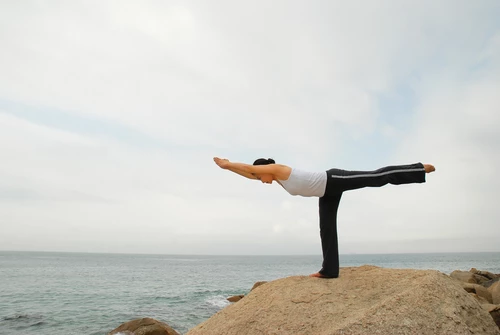Study: Yoga Improves Balance, Helps Prevent Fractures in the Elderly

For people with osteoporosis, the importance of strengthening the bones is well recognized. However, the leading cause of fractures of the hip and wrist in the elderly is not osteoporosis in itself, but rather falls. If you can prevent falls, you can prevent hip and wrist fractures in people with osteoporosis, irrespective of bone mass density. How do you improve balance?
According to a new study appearing in the International Journal of Yoga, yoga shows promise as a therapy to improve both balance and coordination in the elderly. The study followed 14 seniors with an average age of 88 who had suffered several previous falls. The seniors participated in a one-hour chair yoga session twice a week for 8 weeks. The yoga asanas included were chosen to strengthen the musculo-skeletal system and improve balance and agility.
After the study period, the seniors were tested for balance, fear of falling, ability to reach with arms, use of assistive devices, and how long it took to get out of the chair. Results showed that not only could yoga be safely practiced by elderly patients, they improved in all measures, including better balance and reduced fear of falling.
Three of the participants were able to stop using assistive devices altogether. Because some of the patients didn’t improve enough to be out of danger of falling, the researchers proposed that more studies be done for longer lengths of time, or that yoga be added as a permanent therapy in retirement communities.
Falls are a leading cause of fatal and serious injuries in those over the age of 80. And the danger of falling or the experience of falling creates fear that becomes debilitating. Fear of falling prevents people from leading full and active lives, increases depression and starts a vicious cycle in which fear prevents movement and lack of movement makes the patient’s balance, walking gait and confidence further deteriorate. Fear of falling can affect the whole quality of life including social functioning, ability to take care of oneself and general mood.
Fear of falling often also causes people to move less, creating a vicious cycle in which lack of movement results in stiffness and stiffness prevents further movement. Increased confidence in balance, strength, agility, mind-body coordination and perception of the body in relation to the environment can benefit anyone from the very young to the elderly.
Because fear of falling is created by mental, emotional and physical causes, it has been hard to treat, say the researchers. But hatha yoga, because of its active mind-body component, has been particularly promising in treating this problem. Not only do the poses strengthen and increase flexibility in the lower body, but the breathing exercises relax and oxygenate tissues, and the mind is employed in focusing on the body and what it is doing, thereby culturing the mind-body connection and enhancing the yoga practitioner’s sense of where they are in space.
A prior 12-week pilot study published in the Archives of Physical and Medical Rehabilitation found similar results. In that study, in addition to tests for balance and fear of falling, participants were also tested for upper and lower body flexibility before during and after the study period. Fear of falling decreased by 6%, balance increased by 4% and lower body flexibility by 34% in study participants. The study concluded that rehabilitation therapists will find yoga practice to be a promising therapy for fear of falling, both because it both decreases anxiety and the actual likelihood of falling.



